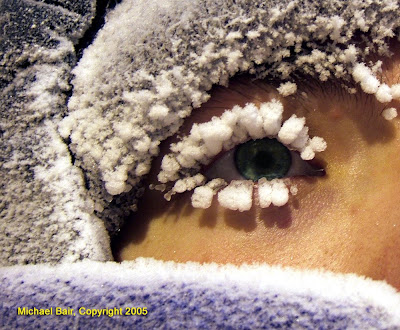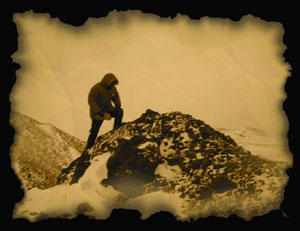PART II: On Thin Ice
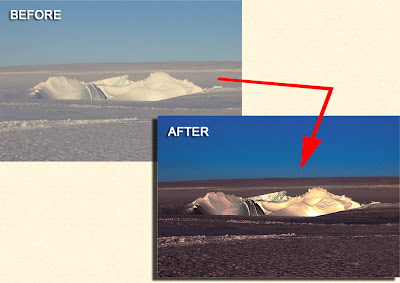 ON THIN ICE
ON THIN ICE(or How I Learned To Stop Worrying And Love Photoshop)
When I went down to the Ice I brought along my 12" PowerBook, an Apple laptop, and used it to write this blog one misspelled thought at a time. My main reason for buying the computer though was to store digital photos as quickly as my friends and I could take them. Over 6000 in all.
It was wonderful being able to sit in the privacy of my room and type away, skimming through photographs for my next blog entry, but I could not upload the originals. Our satellite's narrow bandwidth allowed only a trickle to escape to the outside world, so each photo had to be scaled down, making it about twelve times smaller (just small enough to make this blog possible).
When opening an image to resize it, all sorts of other things can be done depending on the software you have. And in this, one program stands alone, a mountain among mole hills, a wolf among sheep, a titan among... well...un-titan like lesser things - Adobe Photoshop.
[LOUD APPLAUSE]
But wait. What's that, all but drowned out by the thunderous cheers of countless millions? Is it? Is that a BOO? And over there in the shadows, is that someone making raspberry sounds? How rude :(
There is, among photographers, an ongoing debate, a struggle over the use of post-production tools like Photoshop. Adobe Photoshop is a powerful graphics editor, and can (in the right hands) save a poor image, brighten, sharpen, and color correct a picture that would normally be discarded. This is all well and good, but that is not the extent of Photoshop's capabilities. What else can it do? How about this:
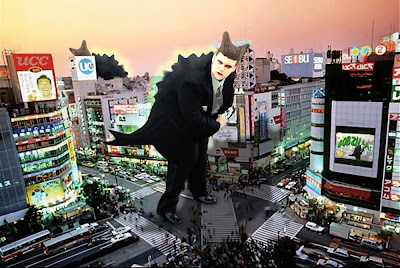
Or this:
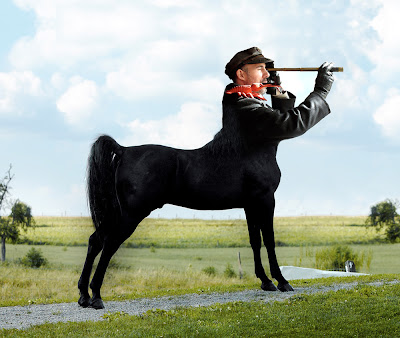
Or this:

And it is that third picture we really need to talk about. It is a composite, a before and after showing how Photoshop can alter the "reality" of an image. Remember those boos and raspberries from the audience? I hear them whenever I alter a photograph. How far can you manipulate an image before it no longer represents reality? How far can you push before it misrepresents the very thing it depicts? When is it wrong to do so? Are there ethical, as well as artistic issues at stake? Can we no longer believe our own eyes?
Ash wanted to know if Antarctica is really as beautiful as my photos make it look. Antarctica does not disappoint, fantasy made real, every bit as surreal and strangely beautiful as anything I've shown you in this blog. Having said that, let me go further and state, for the record, that my use of Photoshop was very limited. Those images above were all creations of mine. I'm comfortable with image manipulation, but wielding Photoshop like a weapon, abusing your trust, would be unfair, misleading, self-defeating, and wholly unnecessary. Antarctica is so beautiful that it hurts to look at. There is no reason for me to show you some "alternative" Antarctica. The real one will do nicely.
Then what is that last picture all about? That picture represents the furthest I ever strayed when altering images for my blog - the one time I risked walking out on thin ice. What you see is the original, untouched image, and a "corrected" area for comparison. I only used that smaller, color-corrected section in a previous entry, #17: "Nacreous Lashes". Every other image in this blog is a close match to the original. A few needed color correction, some cropping, a bit of sharpening, but nothing radical, and in every case those adjustments brought the picture closer to what I actually saw and remember.
Here is how I justify cropping and color-correcting that one image as much as I did. Tyler and I had been working outside. The windchill had dropped to a brutal 92 below zero, though I have no memory of being cold. I remember us laughing as we worked. Tyler was a funny guy. He was impersonating Arnold Schwarzenegger, as if Arnold were actually there complaining like a baby about the cold. Anyway, my eyes suddenly froze shut, something that had never happened before. I forced them open and looked at his face. "Don't touch your eyes and hand me your camera!" I said with excitement. He naturally moved his hand to his face in response, probably fearing a bad case of frostbite. "It's a great picture" I said, and he relaxed. I had my camera with me that day, but his was far better, a Fuji that cracked from the cold later that month as the temperatures continued to fall.
This occurred in the deep antarctic winter, when we worked by the gloom of large mobile lights that had to be raised and lowered each day. These old units cast a harsh, deep, yellow-sulphur light; but I could not use the (much whiter) flash for such a close shot. It would be over-exposed. I wanted to get as close to his eye as possible without losing focus, but this was the closest I could get. All I could do was hold my breath, guess the best exposure, and try to stop shaking as I removed my gloves and snapped the picture.
It was an impossible situation. The shot should have come out blurry for several reasons, been underexposed, badly distorted (from the proximity of the subject) and terribly yellow. When I got it back to the computer I could not believe my luck.
When I cropped the shot in Photoshop, I was compensating for the physical limits of a camera. It had proven impossible to get that close, so I had taken the shot KNOWING I was going to crop it later, and aimed the camera with that in mind. The color correction is too vivid, yes, but I allowed heavy color saturation in this one case. I made an exception. In my own defense, the dull color you see in the original above is not what we saw at all. The camera was working in difficult conditions and greatly exaggerated the yellows. All the colors in the cropped area were really there, Photoshop just revealed them by removing that layer of yellow light.
So Ash, I hope I have answered your implied question. I tried to take artistic shots down there, compelling shots, but generally used Photoshop with one hand tied behind my back. As for the one time I walked out on thin ice, well, my intention was always to write an entry specifically about that, but Antarctica just kept "happening" around me, and I let the opportunity slip away.
I leave you then to contemplate a cropped, color corrected eye staring back at you through the magic of Photoshop. I began this entry with thanks to Ash, and end it with thanks to Tyler. He kept me sane down there, watched my back down there, and stayed absolutely still for one amazing (and almost impossible) photograph.
